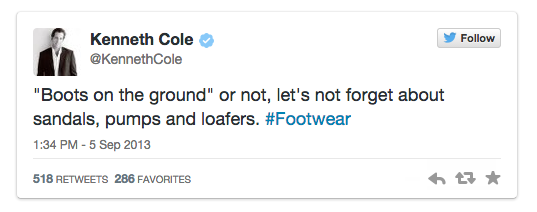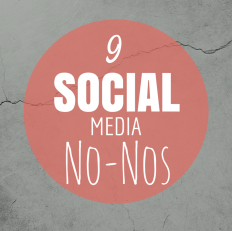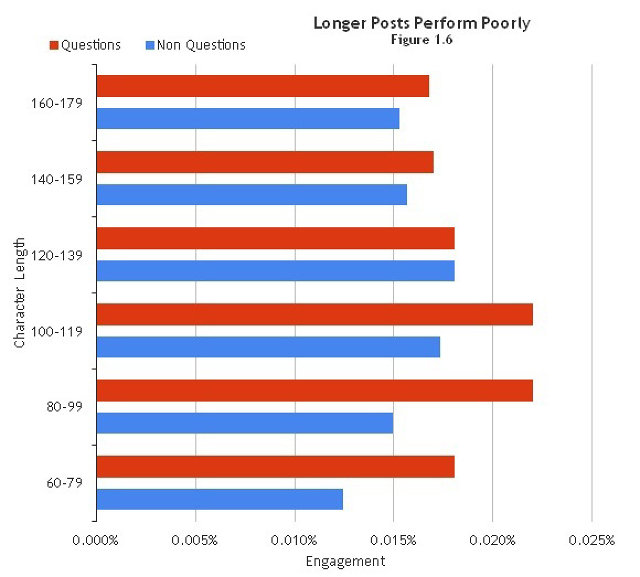9 Social Media No-Nos in Real Estate
You need a drivers license to operate a car. You need a passing transcript to graduate college. But all you need to create a social media account is an email address and a username. There are no gatekeepers; the social media landscape is basically the wild west.
Every social media platform comes with a set of rules – especially for real estate businesses. Unfortunately, these rules are unspoken, and sometimes you have to find out about them the hard way.
But never fear: we’ve prepared a list of the top social media no-nos for real estate companies so that you can avoid them.
1. Blabbing on and on about your company.
Don’t let your entire timeline or Twitter feed turn into a sales-y pitch. Your company is run by people, not robots. The rule of thumb is to use 80% of your posts for conversation and 20% of your posts for promotion. Key takeaway? Be likable, or forever turn away potential leads.
2. Long-winded posts.
The U.S. Navy created an oft-quoted acronym in the 1960s: K.I.S.S. In other words, “Keep It Simple, Stupid.” The KISS principle dictates that most systems work best when made simple, not complicated.
The KISS principle also carries into social media; the ideal length of a tweet is less than 100 characters, and the ideal length of a Facebook post is less than 40 characters. Posts that follow these guidelines receive up to 66% more engagement. Give your fans room to talk, too!
3. Stretching yourself thin on social media.
We’ve said this before, and we’ll say it again: you can’t be everywhere at once. Pick a handful of social media sites that work best with your company and your business goals. Leave the rest alone. Too many social media pages means not enough time to make them shine. Choose wisely.
4. Posting content outside of your industry.
 When you’re a real estate company, your fans follow you for a reason. Don’t clutter their newsfeeds with anything unrelated to your office or the real estate industry in general. Staff photos, merger announcements, and real estate trends are fine. News stories – especially tragedies – are off-limits.
When you’re a real estate company, your fans follow you for a reason. Don’t clutter their newsfeeds with anything unrelated to your office or the real estate industry in general. Staff photos, merger announcements, and real estate trends are fine. News stories – especially tragedies – are off-limits.
Kenneth Cole is the infamous poster child for using social media to inappropriately reference his brand. It never works, it enrages his followers, and it casts his company in a negative light. Don’t be like him.
If a serious event happens, people want to learn about the details from news sources. Any post of yours about the event could likely be seen as an intrusion. Play it safe, and let it rest.
5. Focusing solely on likes and followers.
Likes and followers are called vanity metrics for a reason: the numbers make you feel good about your company, but they don’t necessarily translate into a successful web presence.
When social media first started picking up, some companies began buying Facebook likes and Twitter followers by the hundreds Wrong move. Sure, the numbers looked good on paper, but no one was actually engaging with their brand.
When measuring your social media influence, focus on engagement to report your success: comments: comments, conversations, retweets, etc.
6. Posting exact copies of your content across all social accounts.
No one likes a copycat, even when it’s you copying yourself. If you post the same exact content to your Facebook, Twitter, Pinterest, and LInkedIn pages, then you’re probably boring your followers to death. If you post the exact same information to all of your pages, then what’s the benefit for your fans in following all of your pages?
You can still post the same blog posts and articles to each of your social media pages, but take the time to craft different intros and angles on the piece. This strategy gives your articles the maximum amount of exposure without being overly repetitive. Also, take the time to present the same blog posts and articles in different mediums. If you share the text-only version on Facebook, then share an infographic about the piece on Pinterest. This strategy varies your social media appearance and makes things a little more interesting for your followers.
7. Not experimenting.
Always. Be. Experimenting. How else can you improve your social media strategy? Think about the format and layout of your posts. Try different kinds of visuals to reach different audiences. Try interviews, Q&As, and regular ol’ blog posts.
8. Ignoring the data.
This mistake goes hand-in-hand with experimentation. What good is it to experiment if you’re not looking at the numbers? You should constantly monitor your content to see which posts get the most traction and which posts are left in the dust.
Each of us creates content around gut feelings about our audience and the market. But in the end, gut feelings don’t always lead to success. Numbers show you how your content performs in the real world. Listen well.
If one of your posts gets 10 comments and a retweet while another gets two comments and zero retweets, then it’s obvious that the first post was more successful. As you move forward in your content, refine your approach to mimic you most successful posts.
9. Not pointing posts to your website.
Each post or tweet is an opportunity to point your followers to your website. Since your website should be designed around lead generation and strategic calls to action, it behooves you to funnel as many people to your site as possible. Any time you promote a real estate listing online, make sure to tie your website to it.
Even then, there is a fine balance between posting too much about your site and too little. Don’t spam your followers with tons of links to your homepage; the trick is to send your followers to interior pages in your site when those pages are relevant to your posts.
Have you ever made a mistake on social media? How did you fix it? Let me know in the comments below.



